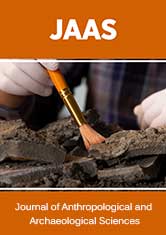
Lupine Publishers Group
Lupine Publishers
Menu
ISSN: 2690-5752
Research Article(ISSN: 2690-5752) 
The History of Human Civilization from the Religious Views Volume 9 - Issue 5
Wanpeng Sun* and Jasper Sun
Faculty of Science, University of Alberta, Canada
Received: June 26, 2024; Published: July 10, 2024
Corresponding author: Wanpeng Sun, Faculty of Science, University of Alberta, Canada
DOI: 10.32474/JAAS.2024.09.000321
Abstract
Due to the continuous geological moment of earth surface and technical limitations, an ordinary human is never able to reveal the events in the early stage of earth. Dinosaur fossil is a great discovery, and it is actually very new events comparing with the real age of earth. To date, the oldest fossil is the microfossils discovered in Australia, which could be nearly 3.5 billion years old. The oldest in-place Earth rock might be in the Canadian Shield, which is thought to be 4 billion years. What happened before 4 billion years? Scientists did not know, but can develop some hypotheses or theories, though they are lack of real evidence. Those so-called theories have restrictions due to the limitations of human knowledge. For example, in most popular theories, the earth age cannot exceed 5 billion years. There was a report about a rock that is far more than 5 billion years, and it was immediately disregarded as a technical issue. The ideology behind: because the universe age is only 13 billion years according to Big-Bang theory, so our solar system is shorter than the so-determined 13 billion, and the earth is even shorter. Previously, we have proposed Sun Model of Universe. According to our theory, the Big-Bang theory is not necessary to be true. Moreover, there are more and more discoveries that are challenging the popular ideas about the ages and formations of the sun, the earth and the human species. It is possible that the age of earth and the history of human civilization could be longer than previous thoughts. In this article, we re-examine the human civilization and some earth event from the religious books authored by ancient saints.
Keywords: Human Civilization; Sun Model of Universe; Buddhism; Great Canons of Buddhism; Holy Bible; Blue Sky; Sumeru; Age of Earth
Introduction
Due to the continuous geological moment of earth surface and technical limitations, a general human is never able to reveal the events in the early stage of earth. Dinosaur fossil is a great discovery, and it is actually very new events comparing with the real age of earth. To date, the oldest fossil is the microfossils discovered in Australia, which could be nearly 3.5-billion-year-old. What happened before that? Scientists did not know, but can develop some hypotheses or theories, though they are lack of real evidence. Those so-called theories have restrictions due to the limitations of human knowledge. For example, in all those theories, the earth age cannot exceed five (4.54) billion years. There was a report about a rock that is far more than five billion years, and it was immediately disregarded as a technical issue. In solid scientific experiments, one time data is not data. So discarding such data is not always considered as a wrongdoing. Nevertheless, such discoveries has disobey the underground ideology: because the universe age is only 13 billion years according to Big-Bang theory, so our solar system is shorter than the so-determined 13 billion, and the earth is even shorter. Due to the continuous geological moment of earth surface, the older of a rock, the harder to find it. We have proposed Sun Model of Universe previously [1]. According to our theory, the Big-Bang theory is not necessary to be true. Moreover, there are more and more discoveries that are challenging the popular ideas about the ages and formations of the solar system, the earth and the human species. Thus, the age of earth and the history of human civilization should be re-examined.
We also proposed the Sun Theory of Evolution and Sun Model of Civilization [2]. It is speculated that human could have better civilization than the current version, and the ancient civilizations start much earlier than the modern history starts. In this article, we re-examine the human civilization and some earth events from the religious books authored by ancient saints.
It is noteworthy that there are three major approaches to study the ancient history of human civi-lization: 1. History-related Record; 2. On-site Discovery; 3. Supernatural Exploration. The histo-ryrelated record could be formal historical books, or prehistorical paintings/drawings found in ancient caves. From these evidences, people can find clues about ancient civilizations. For example, if we see an ancient painting shows a cow with some backgrounds like a farmland, we can conclude that the cows have been raised for agriculture by the time of the paintings. On-site Discovery refers to the studies of an ancient site. This site could be a tomb or any debris of a temple, village, city and so on. The scientific testing like radioisotope assays can help determine the age of the site e.g. analyzing the stone tools, fossils or relics. There are technical limitations [2]. Moreover, as aforementioned, the active moment of the earth surface has hided and diminished many evidences that could have been discovered by modern scientists. The supernatural exploration is usually only accessible to top elites, and often carried out secretly by higher officials, because most public civilians are not able to believe that. For example, CIA has explored the ancient Mars by a person who has supernatural abilities [3]. That person is able to visualize Mars and see what happened a million years ago. Regarding supernatural abilities, there are different levels. Who have the most powerful supernatural powers? Apparently, the ancient religious leaders that built up a long-lasting religion have the most powerful supernatural abilities than others. For example, Moses was able to split the red sea with the help of God [4]; none of modern humans is able to repeat. Thus, it is an innovative and resourceful approach to study the human civilization and even some earth events from the religious books authored by ancient saints.
View Points from Regious Books
In Western, the most known religious views about the earth and the human early history are from the Holy Bible. The stars, the sun and the earth were made by God. The human ancestor was made by God. Human’s sin, Big Flood, and a number of prehistorical events were written in the Old Testimony. In addition to Christianity with the largest religious population in the world, there are other two major Abrahamic religions, Judaism and Islam, both of which are also the major religions in the world. Their viewpoints have been well known to most audience.
On the other hand, in Eastern, the Great Canons of Buddhism (Great Canons) are the record of Buddha’s words and actions. In Buddhism, the canons refer to the sacred texts, authoritative and foundational to the teachings of the Buddha, Siddhartha Gautama, who delivered teaching for over 40 years. There are huge volumes of canons transcribing his words into scriptures (books, Figure 1). Such canons are rarely known to the western wisdom due to the cultural and language boundaries.
Figure 1: The Great Canons of Buddhism records the Buddha’s teaching. Despite of missing books throughout thousands of years of history, there are still huge volume left, enough to fill a community library.
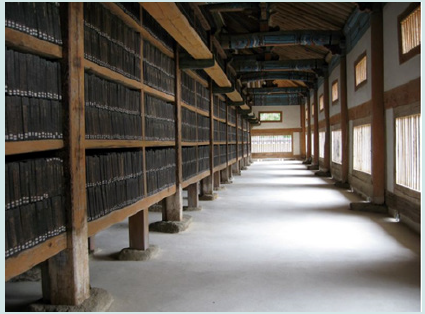
The Great Canons of Buddhism
The Great Canons of Buddhism are the collections of all those canons. Regarding our human and earth histories, there are more details recorded in these Canons. In ancient time back to 3000 years ago, there are no computer, no internet, no phone and no printer/copier; there is no modern storage conditions and no ever-lasting paper/ink. Therefore, it is very hard to preserve and spread all Buddhism scriptures. A handwritten paper, at that time, was usually lasting 3-10 years, due to environmental harms and the natural degradation of the paper/ink over time. Very few books could last up to 20 years when they are in circulation, and last up to 100 years when they are not in circulation. It is noteworthy that human knows how to make paper much earlier than most people think; however, it is very hard to preserve the paper and even harder to preserve the technique of making paper. The oldest fragments of paper, dis-covered so far, can be dated back to 800 BC. In order to preserve a book, especially the 2000+ years of period from the time of Shakyamuni Buddha to the Industrial Revolution, it has to be in handwriting, generation by generation, with tremendous efforts. It is noteworthy that there are ancient printing tech-niques, in which you need to use hands to align up the character one by one, line by line and page by page or craft the characters into something like a wood one by one, line by line and page by page; however, the Great Canons have over billions of characters. It is a huge job. In order to complete the printing of all or even parts of those canons, it usually has to be sponsored by a government. There are more jobs to gather scriptures into a canon and perform the quality controls. For example, the Great Canon of Qianlong (Figure 2 and Figure 3) has costed nearly 100 years and the national-wide resources of the strongest country before the Industrial Revolution in order to produce it. More details will be discussed in following text.
Figure 2: The Great Canon of Qianlong is one of the best collections of Buddhism scriptures. The above picture shows the cover for the Great Canon of Qianlong.
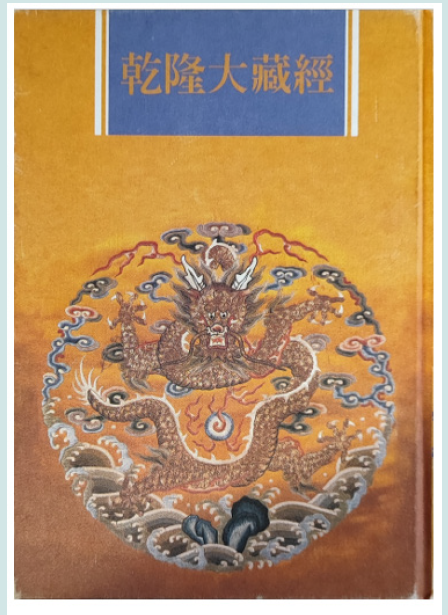
Figure 3: The Great Canon of Qianlong is well prepared. Even the paper is high-quality paper at Qianlong’s time. The above picture shows the first page for its table of contents.
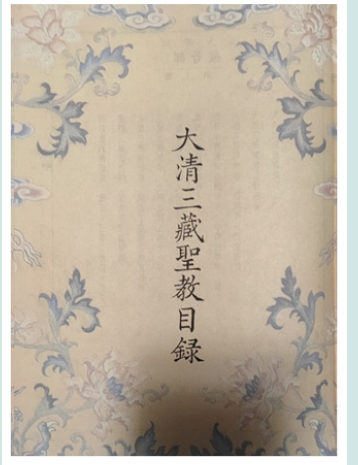
There are different version of Great Canons of Buddhism due to different scripture collections. Buddha’s teaching originated from India and surrounding areas, spreading into the world. Its original place was conquered by Muslim. Hundreds and hundreds of years later, the British defeated Muslim. Based on a book written by an ancient Chinese monk, Xuan Zang, the Europeans re-discovered Bodh Gaya, the holy place where Gautama Buddha attained enlightenment. Xuan Zang is a famous monk, who faithfully translated Buddhism sutras which are now entered the collections of Buddhism canons. He travelled to India before Muslim Conquest. The university he studies is the famous India’s Nalanda University, which was home to nine million books. The remains of Nalanda was also re-discovered (Figure 4), but it only has relics without books. Later on, there are colleges built up and still use the same name of Nalanda, but it is a different story. Anyway, it is an extremely difficult job to collect all Buddha’s teachings into one big canon collection. In India and surrounding areas, Pali is one of popular languages while the Sanskrit is the formal sacred language. There are the two main languages that record the Buddha’s teaching. Many Mahayana scriptures were written in Sanskrit because this language do not change with time, just like the dead language Latin which has almost no changes from ancient to today. Thus, similarly as the usage of the Latin language for scientific taxonomy, Sanskrit is used to record many important Buddha’s teachings. The Sanskrit is not easy to learn; however, Buddha and many his followers are well-educated scholars and/or from Royal families, and some of them were even the candidates for kings; to preserve the Buddha’s teaching, the Sanskrit is used to write many formal scriptures (sutra). The word of sutra also originated from the Sanskrit, meaning “well spoken”. To date, there are three groups of Great Canons, based on the recorded languages. Pali (language) Canon, also called Pali Tipitaka, is known as a very early version of canon, where many nomenclatures are similar as Hinduism, since both Buddhism and Hinduism were originated from similar regions, using similar languages. In addition to Pali Canon, there are other two main Buddhism Canons: the Chinese (language) Buddhism Canons in China, Korea and Japan, and the Tibetan (language) Buddhism Canons used in Tibetan Buddhism. In these two groups of canons, the Buddhism sutras were translated into either Chinese language or Tibetan language. In the Chinese Buddhism Canon, there are early-translated Buddhism scriptures (e.g. during the Han dynasty about 2000 years ago). There are no ways to know which languages they are originally written. The Tibetan (language) Buddhism Canon is mainly trans-lated from Sanskrit language and Chinese language to Tibetan language. Because there is a historical period in Tibet that the Buddhism was completely abandoned by the Tibetan King Langdarma during the 9th century, major Tibetan canon collections are from the translations after that dark age. All three sys-tems of canons (in Pali, Chinese and Tibetan languages) have records about the universe, the earth, and human history.
Figure 4: The Nalanda College in India was a college influencing the world in ancient time. It has millions and millions of collections of Buddhism scriptures. Due to historical reason, it has become relics. Before this hap-pened, some of the Buddhism scripts have been translated to other languages and spread into other countries. Now, some Indian scholars have seek the help of other countries to translate back from their collections.
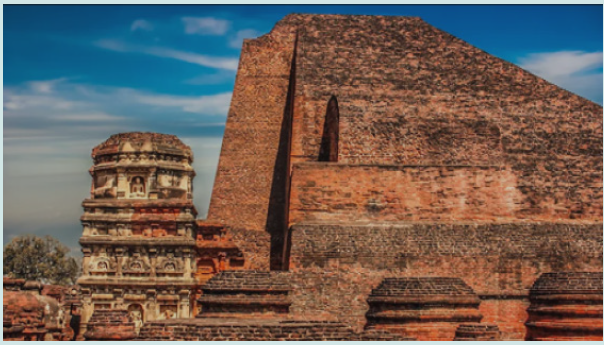
Among all available cannons, the most faithful and popular records are the Great Canon of Qi-anlong (also known as the Dragon Tripitaka, Qing’s Treasure, Qianlong Tripiṭaka, or Great Canon of Qianlong). It is written in four languages, Chinese, Tibetan, Mongolia and Manchu languages. It is ac-complished through the hard work of a number of great people, especially Qianlong King (Figure 5 and Figure 6) and his father, Yongzhen King, with the nationally-wide efforts and resources of the whole China. At Qianlong King’s age, before Industrial Revolution, China is a richest country based on the Agriculture Civilization; it also includes Tibet, Mongolia and the huge northern land (over 1,600,000 square km, part of which is the original place of Manchu where Qianlong’s ancestors lived) later-on invaded by Russia. This is why the Qianlong Tripiṭaka were produced using these four languages. In Qianlong’s time, his country was contributing to more than 95% global GDP. He and his father, whose religion is Buddhism, especially Tibetan Buddhism, used the entire country’s resources to complete the Great Canon of Qianlong in almost 100 years, starting from the thirteenth year when his father became the king (Figure 7) and completed around sixty years after Qi-anlong, himself, became the king. In addition to paper, they also printed this Great Canon in hardwood, in order to preserve for long time. It is noteworthy that Qianlong Tripiṭaka also contains the Tibet Buddhism Scriptures (e.g. Vajrayana) in Tibetan languages, which entered Tibet after the dark age when the Buddhism was almost completely removed in 9th century by their governor Langdarma. Before Qinglong and his dad, there are also many historical efforts to translate and collect Buddhism canons in Eastern Asia, and this makes the hard job relatively easier.After industrial revolution, Japan also made a collection of Buddhism Canons called Taisho Tripiṭaka (also called Da Zheng Treasure). It is noteworthy that the Japanese version is originally written in Chinese characters. Just like today’s English, in ancient time Chinese language was used in many ancient countries including Japan and Korean. Moreover, it is hard to find a qualified translator to translate between languages. To preserve the authentic meaning, this version still used Chinese language, plus new comments in Japanese by scholars in the 20th century. It is also a very good collection. The majority of them are same as the collection of Qianlong Tripiṭaka; though there are different sequences. In the Japanese version, it also collect some sutras that have not been collected by the Qianlong’s version. This is very good. Nonetheless, it also collects some things that were rejected to take into Buddhism canons by some scholars. It has a section called Likely Volume (In-doubt collections) for teachings that scholars cannot tell whether it is from the Buddha. Anyway, it has been 3000 years from Buddha, and hard to tell if some books are original teaching or not. This is just like the time when deciding which books should go to Bible during Roman’s time. It was said there were more than 88 books written by saints, Jesus’s disciples or followers, but not all the books can be included into Bible, since it is a very serious scholarly event. Thus, the writings in the Likely Volume will not be quoted for this study.
Figure 5: The official portrait of Qianlong Emperor, who is a key funder to produce the Great Canons.
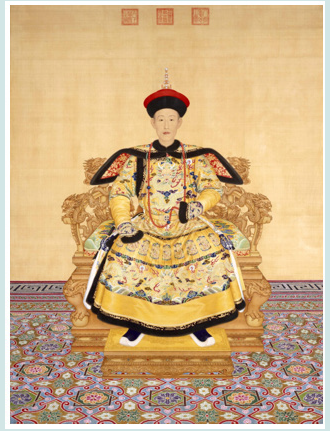
Figure 6: Another portrait of Qianlong Emperor. In this portrait, he looks more like a scholar. Ac-tually, he has another career: a great scholar with 10,000 poem left in this life. In addition to Great Canons of Buddhism, he also contributes to the production of another huge collection for all known books at his time.
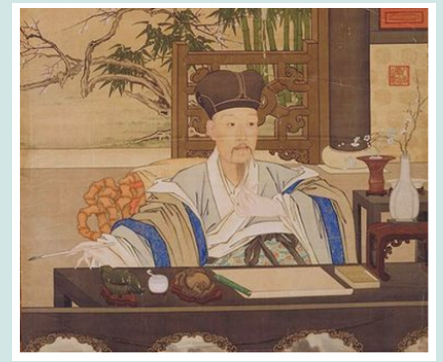
Figure 7: The preparation for Great Canon of Qianlong starts from the 13th year when Qianlong’s father be-comes the Yongzheng King. The picture shows this work is ordered by the Yongzheng King, who also wrote the dedication part for this collection. The four characters near the left bottom corner is translated as “Dragon Tri-pitaka authentic version”.
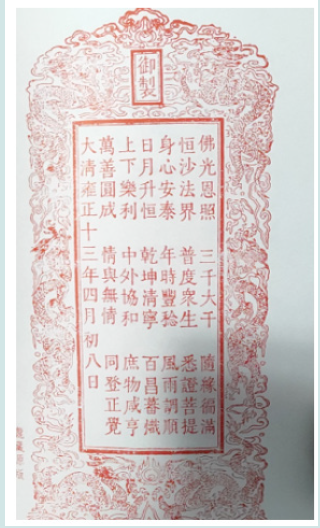
The Great Canons of Buddhism preserved the records about the Buddha’s observation by his su-perpower on the earth, the universe and the human history. Due to language boundaries, not many scholars are able to read. Regarding our human and earth histories, there are more details recorded in these Great Canons. The following texts will discuss the view from Siddhartha Gautama, who is com-monly referred as the Buddha.
Earth Origin and Prehistorical Events
Earth origin. These topics about the earth and human origins have been recorded in many sutras, especially the World-forming Sutra (Qishi Sutra). It has different versions as recorded in the Great Cannons; it describes Buddha observed and told how the earth is coming into being. Before the earth coming into being, there are hot liquid, and then cool down and form the earth. This process is somehow similar to the popular modern theories about the Cooling and Condensation. Where such hot liquid comes from, according to Buddhism? Well, when the earth came into end, there will be nine starts like Sun closing to earth and burn the earth, as well as many other things including themselves, into very hot matters. That is called the Fire Kalpa. The word of “kalpa” in Buddhism and Hinduism refers to a cycle; for extended meanings, it also refers to the end of a cycle (e.g. disaster) or refers to a long period. This is different from the Big-Bang theory. Then, something like lava cooling down and form the earth. From this point of view, it is a cycle. Each cycle has a unique name. Our current cycle is called Sage Kalpa, because there are over 1000 lotuses that were floating on the lava-like hot liquid even before this world was formed. There were god-like high dimensional beings who observed this impossible phenomenon and thought that is an indication for over 1000 sages (Buddhas) who will appear in this kalpa. The previous cycle is called Glorious (Honorable-looking) Kalpa (vyuhakalpa), because most of the human beings in that cycle have honorable, big and glorious images, able to live for over 80,000 years or longer. For example, the famous Light Burning Buddha has the body height of 88 cubits (1 cubit is more than 1 feet, the distance from tip of finger to the elbow). It is noteworthy that the ancient Sumerians, Egyptians, and Israelites are known to use the cubit as the distance unit. The term cubit is also found in the Bible [4] regarding Noah’s Ark. Near the final stage of that Glorious Kalpa, there was decline of morality and people became sinful and less honorable, and only able to live about 70,000 years, then 60,000, and then 50,000 years, which are still extremely long life spans comparing with the modern human. The next cycle is called Star (Naksatra) Kalpa, because there will also be 1000 Buddhas in that cycle and they look like the constellation. Each cycle has some unique characters, not exactly same. In our current cycle, the moon has the shade like a rabbit, the reed near lakes is hallow in the middle, and some places will never be burned by wild fire…… These are unique traits comparing to other cycles. The numbers of cycles are countless, out of the scope of any human’s or computer’s calculation; but it still has a limit. In addition to Fire Kalpa, there are alternative pathways when the earth came to the end according to Buddhism scriptures. In addition, there are other planets which are formed in the same cooling-down process like the earth. There could be civilizations in other planets. The other civilizations in other planets also called their planets: the earth. How can people distinguish between each earth? Well, in our solar system, ac-cording to the Buddha, our earth has a specific name, called Yanfuti (Jambudvipa), because there are tree-like dark matters called Yanfuti Tree (like a very huge giant Jambu tree) which is rooted from (connect to) our earth. The tree is not like an ordinary matter that is visible to human, but we can see its shadow on moon.
Shadow on Moon. The above-mentioned Yanfuti Tree is giant and it can filter part of sun light. Thus, it projects its shadow on the moon. Its shade, like a tree shade, provides a cool place to rest. This is in line with the modern discovery that ices exist in the shadow region on moon. It is note mentioning that the shadow regions could be collocated with the deep bottom(s) of crater(s), but not always. Nowadays, people can take pictures of moon by many tools. Examining carefully, the shadow is connected, and shades half of the moon surface. Craters cannot make this effects. Three years before Apollo 12 mission, NASA sent a spacecraft called Surveyor 3 to moon. After 3 years, the Apollo 12 landed onto moon. At the beginning, its astronauts P. Conrad and A. Bean thought the Surveyor 3 located in a slope because part of the Surveyor 3 was sunlit and the other part is in a shadow: “if something is sunny on one side and very dark on the other, it has to be on a tremendous slope”, said Bean [5]. When they walked to Surveyor 3, they found the ground was actually flat, with no more than 10-degree slope. This strange phenomenon can be perfectly explained by the Yanfuti Tree theory mentioned in Buddhism Sutra: a huge tree that shade the surface of moon. To answer Mr. Bean’s comments: if something is sunny on one side and very dark on the other, it could be observed simply standing beside a tree. The tree-like dark matter is invisible to most humans because of low density; but, thanks to its huge volume, the accumulated effects are visible: we can see its shade on moon. According to Shakyamuni Buddha, the shadow on moon is due to the huge tree (tree-like dark matter) that shades the surface of moon.
Sun after Earth and Animal after Human. According to the Buddhism scripts, the earth is coming into being before our sun and moon show up. It is in line with the Bible, which mentioned the earth is “made” before the light shows up. Human has been in the earth for far more than billions of years according to Qishi Sutra. This will be discussed in following text. At early stage, human bodies are il-luminate light, no need of Sun. Later, the intensity of lights decay because of humans eat food from the earth. This seems different from current believes, which assume the sun was formed earlier than the earth. There are parables in current scientific discovery: just like the deep see environment under ocean, there are species which can emitting light. So do the early human. Human beings were born into the earth much earlier than most animals, which cannot survive without of the sun. Somebody did bad actions, reborn into animals. The world for “animal” in Buddhism scriptures were faithfully translated as “beside being”. They lives beside human.
Human Origin. The first human is from Guangyintian realm, which, according to current scientific understanding, is a realm with very high dimension in the universe. Their dimension is able to avoid the Fire Kalpa, and their people live longer with superpower. They came to earth like suddenly showing up (born by illustration), not via any embryos or eggs. It seems hard to understand; but if it is true, it can also solve some paradoxes, such as: who is first? Egg or chicken? There are no need to egg/embryo to have the first human. The first batches of human beings can illuminate light, no need of the sun and the moon. Later on, because human eats too much food from earth, their light become darker and darker. Even now, some elites with superpower can see humans’ light, but no as shining as that in the early stage. The human beings eat the food from the earth. The first food from earth is not from agriculture; instead, it is more like oil: some tasteful liquids and then semi-liquid food directly flowing out from the earth, which are translated as the earth milk and earth honey. At that stage, the earth is more like the Bible’s saying, “a land of milk and honey”. The more they eat, they less light they emit, the more ugly they become, and the most superpower they lost. Even now, scientists can detect the electromagnetic waves that human body illuminate. Become they have less light emitted, darkness came. Later on, the sun and the moon came into being. There was a dark age between the first batches of human and the formation of the sun/moon. Since the sun and the moon came into beings, calendar starts, and then the concepts of 1 day, 1 month, half month, year, season come into being. All of these events are far from the record of any historians, but the Buddha observed and told his disciples as recorded in Great Canons.
Figure 8: Asurais, a god-like being with powerful fighting capability. They live in cities near the bottom side of Sumera (Mt. Meru). They communicate each other by hearts (mind thinking). They have a higher dimension than modern people: modern human cannot see them, but they can show their body to human if they want. It was translated as Demigod by Buddhism or Hinduism scholars; but they are not demigod because demigod is a word from Greek meaning the part-human and part-divine offspring.
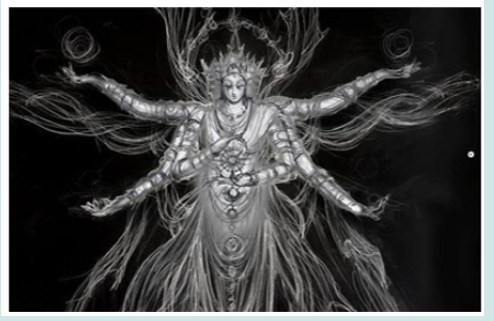
Decline of Morality. At the early stage, human can fly both in sky and in the ocean. They can emit light. Thank to eating foods from the earth, they lose some power and lose the god-like image. Some of them, who eat less earth food, have a more glorious look than those who eat more earth food. They start decimations based on people’s outlook appearance. They insult one another, become jealous and laugh at each other: you are ugly… what… you are ugly… They start to do bad deeds. Because of the law of karma, they lose more power and life spans. Later on, they are committed to adultery. Further, some people start to store food for their future, and the “self” concept starts emerging. Even though, they still have better images, extremely longer life span and more giant body than modern humans can imagine.
King’s Linage and Early Human Society
Start of Kings. The first food from earth is some tasteful liquids or semi-liquid food directly flowing out from the earth. The names of such food are translated as the earth milk and the earth honey/ cheese. Later on, the rice starts growing from the land and human starts to eat rice. People have their private land. However, there are persons who did not follow the rule and steal other’s rice. Thus, there are disputes and they need a leader to make decision who is right and who is wrong, maintain the order and enforce the rule. The first king came out, and he is called “dishali (kṣatriya)”, which is meaning the Lord of Farm. The most function of this King is like a Judge. This is in line with the translation of the name of rulers before King David in the old testimonies of Bible: the early-stage ruler was translated as Judge.
Golden Age of First Six Kings. The above-mentioned first king actually has the best image among people. He has super wisdom and his body looks more glorious than others. He judged well and goad people to do good deeds. Therefore, people also called him Yiluozhe, meaning King. Formally, people let him to become the king, named Peaceful Equal King. In the time of Peaceful Equal King, people started to use the name “people”, which is pronounce as Saduobo that means “many persons”. This king has a descendant called Mind Happy to succeed as the king. It is noteworthy that, hereby, the script use the word “descendant” instead of “son” because the people at that time can live very longer; thus, it is not necessary his son to inherit as the king. The age of human will be discussed in following text. Mind Happy is a great king, who was also called Heyimojia (Gold) by people. Mind Happy King has a descendant called Right Truth, who becomes the king. People called him Diluozhe (flax growing). Right Truth King has a descendant called Most Right Truth, who became the king. People called him Abolu-osaituo (cloud pieces). Most Right Truth King has a descendant called Disciplinary, who became the king. People called him Duoluochengjia (wood leg). From the head of the Disciplinary King, a bud formed and the bud became a great-looking baby, named Top Born, who became the king after growing up. If this is true, it is an example of asexual reproduction. Throughout evolution, the modern human species, homo sapient, has lost this capability and no modern human can born in this way. Nonetheless, this could happen in other species. For example, the yeast can have both sexual and asexual reproduction. The asexual reproduction is through budding: a new, smaller organism, like bud, grows directly from the parent organism. The offspring, or bud, gradually enlarges and separates from the parent to exist in-dependently. Top Born King had super and huge power, and ruled four earth-like planets. The above-mentioned first six kings have extremely long life spans; from point view of modern human, it seems “unlimited”.
Top-Born King (also translated as Top Born King) and its encounter with alien-like beings ac-cording to Buddhism. According to Buddha Shakyamuni, the Top Born King spent 84 thousand years on our planet, 4 billion years in the other three planets. These four planets are called the Four Major Planets. In addition to the four planets, there are eight other planets where human can live. These eight planets are called Eight Minor Planets. In addition to the twelve planets, there are over 84000 planets where human live. In Buddhism, any of the four major planets was called a “under sky” in ancient literatures; this is referring to a place where there are colored atmosphere. There are different feelings when you stand under a earth-like sky and watch the space, rather than you stand a rock in the outspace and watch the deep space. Unlike seeing directly to the deep space, you feel you stand under the sky when you watching from the earth. Therefore, the Buddhism literatures call an earth with a colored atmosphere as “under sky”. Because the atmosphere has certain color, when people stand on the ground, they feel like they stand under the sky. In the sutra about Shanjian King (from our earth), it mentioned the Shanjian King has a golden wheel (UFO in today’s nomenclature), which brought him and his follower to another planet with green sky. The Shanjian King explained to the followers why it is called “under sky”. In Buddhism, the smallest unit of universe is called the “four under-sky (objects)”, which are initially referring to four major planets with colored atmospheres where people live. In modern science, atmosphere (sky) is essential for a planet to have lives. In Bible (Genesis Clause 6 and 7), the sky is very important concept named by the God; it is an expanse (like a roof) that separate the water above (e.g. water-like ether which is inviable to modern human but visible to few saints) and water below. Generally, one “four under-sky” in Buddhism scripts not only refers to the four major planets, both also refers to the Mt. Meru (Sumeru) and its surrounding mountains (hereby, the mounts refer to the condensed dark matters), the Sun, the 4 major planets, another 8 minor planets as well as the over 80 thousand of other places. In the deep space, the 80 thousand of other places looks like Islands, so they were called the 84000 islands in Buddhism sutras.
Sumeru. In addition to the twelve major planets (the abovementioned Four Big and Eight Small), there are also several huge objects. These are as huge as “mountains”: in Shakyamuni Buddha’ time, mountain is the largest object with lands that people can think of. In the center of those mountain-huge objects, there is a huge planet-like object called Sumeru (Mount Meru or Mt Meru, Sanskrit/Pali: ), which is like an extremely giant planet (much huger than our earth). There are different groups of god-like beings living in different areas of Mt Meru. According to Buddhism, the sun is rotating around the Sumeru. If this is true, the Mt Meru is more like dark matter that has not been discovered yet. Nev-ertheless, there is a similar planet called Nibiru according to the Šumeru, the famous Shumer Civilization, in ancient Middle East region. It is interesting that they use a similar word with the same pronunciation, “Sumeru”, from two distinct origins (one from Buddhism, referring to a giant planet or a mountain; the other from Middle East (the Arabian and Egyptian regions). To avoid confusion, in the following text, we will try to use Mt Meru more often for the planet in Buddhism. It is noteworthy that, in some modern scholarly articles, many people also thought there should be 12 planets in the solar system; this is in line with the twelve planets mentioned in ancient Buddhism books.
The Top Born King also went to Mt Meru, and spent billions of years in the middle region and spent countless years in the top region. The Top Born King can fly and he also had a special flying vehicle, called Gold Wheel (better than a top-class UFO in today’s language), which let him and his followers flying in sky. When flying in sky, his followers also bring elephants and horses. Those animals need piss and poop in sky, and their poops fall down to the heads of some inhabitants, among whom there are 500 superman-like beings (Sanskrit: Rsi, referring to somebody with characters of both human and gods). These 500 supermen thought they are polluting, so use power to stop those foreigners (The Top Born King’s team from our earth). The Top Born King has more power than those supermen, and finally those supermen have to serve for the Top Born King.
Trāyastriṃśa. The top region is called Trāyastriṃśa (Sanskrit language, meaning a heaven-like place with thirty-three cities where god-like beings live), where the inhabitants are god-like beings. The most powerful being in Trāyastriṃśa is the King called Sakra (Pali: Sakka). Top Born King has similar image as Sakra. However, he is a human and his eyes are blinking faster than those god-like beings in Trāyastriṃśa. Through modern physiology research, we know the eye blinking is a bodily function; it is a semi-autonomic rapid closing of the eyelid. The duration of a blink is only 100 milliseconds. A modern human blinks 12-15 every minute. Most people do not realize their eyes are blinking. It is surprising that the blinking is noted in ancient religious books that were written around 3000 years ago.
Human could be stronger. The Top Born King witnessed 36 Sakras, Kings of Trāyastriṃśa, during his stay in Trāyastriṃśa. According to the famous monk Vasubandhu, inhabitants of Trāyastriṃśa are each half a krośa tall (about 1500 feet) and live for 1000 “heaven years”, of which each day is equiv-alent to 100 years of our earth. According to the Buddha-taught Loutan Sutra, 36,000 years on earth equal to 1 “heaven year” of Trāyastriṃśa, where each “heaven month” is equal to 2000 years on earth. Thus, it seems there are around 18 month per “heaven year” in Trāyastriṃśa instead of 12 month per year on earth. A general inhabitant there can live for over 36 million years [6]. Thus, the life of Top Born King is tremendously long. During the 36th Sakra, the Trāyastriṃśa is attached by another group of god-like being, Asura (Sanskrit: Asura; Asura, Figure 8), who are very powerful. Asura people are able to mate with the people in Trāyastriṃśa.
During that war, Asura defeated Sakra’s troop and Sakra run back to his capital city. In Trāyastriṃśa, there are 33 cities. The center one, surrounded by the other 32 cities, is the capital city, where Sakra lives. Thus, Top Born King had to come out and fight with Asura. Again, the Top Born King won and defeated the Asura. How can the Top Born King have so strong power? Generally speaking, it is the law of Karma. The detailed stories of how he got the non-comparable power is being translated and will share with audience in future publications.
Comparative Studies among Modern Science, Sumeru in Buddhism and Nibiru in Middleeast Shumer Civilization (Šumeru). According to Buddhism, the sun is rotating around the Sumeru. In Buddhism, the Sumeru is also translated as the Mount Meru (“empty” giant mount), around which the Sun rotates. In many Buddhism lineages, like the Kalacakra (Time Wheel) lineages in Tibetan Buddhism, the Sumeru is thought as a huge planet, more giant than our earth. No matter it is a mountain or a ball, it has not been discovered by modern scientists. So it could be a dark matter. According to Buddhism, the sky of earth is blue, because the side of Sumeru (Mt Meru) closest to our earth is made of blue-colored Liuli (artistic glass); the blue-colored glass reflects/scatters the light and make the sky blue. It is an in-novative explanation, because current science cannot flawlessly explain why the sky is blue.
Buddhism provided the most straightforward explanation about blue sky. When we watch the sky, we saw blue color; this is because we are close to a gigantic building with blue glass facing us. In modern science, people thought the blue sky is due to the white light from the sun interacting with the air mol-ecules. The current popular theory is called Rayleigh scattering, named after the physicist Lord Rayleigh. According to this theory, when sunlight enters the Earth’s atmosphere, it encounters tiny molecules of gases such as nitrogen (N2) and oxygen (O2). These molecules scatter the light in all directions, and they seems to scatter shorter wavelengths (like blue and violet) more than longer wavelengths (like red and orange). But the blue wavelength is around 420 nm, the O2 and N2 molecules around 0.3 nm that is roughly 1000 times smaller. How can the sun light interact with air? Well, they made more stories like energy level... Anyway, you cannot immediately prove their stories are wrong. From philosophy, any theory is approaching the truth, but never equal to the truth. It is just a matter of time to find the evidence to show this theory is wrong. According to the Buddhism, there is another planet named North Julu, which is close to another side of Sumeru (Mt Meru), which is green color. According to Buddhism (the Sutra of Shanjian King), the sky of another planet is green, because that side of Sumeru (Mt Meru) closest to that planet is green, and it scatters the light and make their sky green. It is actually not too difficult to verify. With the advance of science and the emerging space competition, human could find a green-sky planet with similar atmosphere components of earth in the near future.
The Sumeru (Mt Meru) mentioned in Buddhism is more like dark matter that has not been discov-ered yet. But there is a similar planet called Nibiru (Figure 9) according to the Šumeru, the famous Shumer Civilization, in ancient middle east region. It is interesting that they use a similar word with the same pronunciation, “Sumeru”, from two distinct origins (one from Buddhism, referring to a giant planet or a huge mountain; the other referring the name of a very ancient but advanced civilization from the Arabian and Egyptian regions. According to the famous scholar, Zecharia Sitchin, Nibiru is a planet. This planet “enters” the solar system once every 3600 years. In Nibiru, there are people who have giant body and live for very long: could be 360,000 years but not forever. This is similar to the abovementioned Sumera (Mt Meru), where there are people who have giant body and live for very long, but not forever. In Buddhism, as aforementioned, the people lived in the Trāyastriṃśa region of Sumera (the top of Mt Meru) can live for 36 million (36,000,000) years. It seems that both cultures are referring to same group of people; the Dr Zecharia Sitchin and his followers got the information via reading and translating the records on ancient relics that could be more than 4500 years ago. Due to the nature of the hard work, missing zeros or converting wrong math units are among common mistakes. Furthermore, movement are relative and one phenomena can be viewed as two distinct stories: assuming the Earth is static, you can view as the Sun rotates around the Earth; assuming the Sun is static, you can view as the Earth is rotating around the Sun. When studying the Shumer Civilization (in Middleeast), Dr. Sitchin assumes the Sun is relative static, so the Nibiru enters the current solar system every 3600 years. In Buddhism, the Sumera (Mt Meru) is deemed as relatively static, so the Sun rotated the Mt Meru each “heaven year”, which, as discussed in above texts, is 36000 earth years. Thus, it took 36,000 years for the Sun to arrive a similar location relative to the Sumera (Mt Meru). This is in line with the Šumeru (Shumer culture), where the Nibiru is believed to “enters” the solar system once every 3600 years. Again, zero missing, and this could due to the same mistakes discussed above. It is noteworthy that, in the Middleeast, the Shumer people or Shumer culture is called “Šumeru”, not because of their willingness. Shumer people was calling themselves as black-head people. In Middleeast, the word of “Šumeru” is used by their neighbor tribe (later on, a country), Akkadi, to refer Shumer people and Shumer culture. Likely, the neighbor may use an obvious symbol (like a mount symbol) to refer Shumer people/culture. Taken together, it is possible that the Nibiru in Shumer culture might refer to the same planet of “Sumeru” (Mt Meru) in Buddhism.
Figure 9: The artistic drawing of the planet Nibiru, according to Shumer Civilization. It might be similar some-thing mentioned in Buddhism literature as discussed in the above text. In addition, some scientists believe it could be the 9th planet in the solar system; in Tibetan time-wheel calendar, there is also an invisible star called Luohou star; however, more evidence are required to support these kinds of speculations.
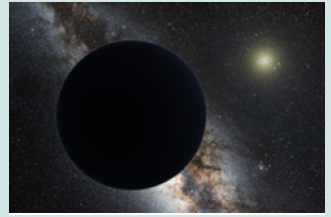
King’s Linage, from far ancient to Shakyamuni Buddha. All of the above-mentioned six human kings lived for extremely long. They taught people to do good things. It is a golden age. The Top Born King’s son is the Right Born King, whose can rule four major planets (four “under-skies”). The Right Born King’s son is the Left Born King, who can rule three major planets. The Left Born King’s son is the Right-Knee King, who can rule two major planets. The Right-Knee King’s son is the Left-Knee King, who can rule over one major planet, our earth. From then on, no more human king can rule other planets anymore. In Buddhism and Hinduism, the best powerful king is called wheel-rotating king be-cause he has a gold wheel, which can fly (like a today’s so-called UFO, Figure 10). From then on, all wheel-rotating kings from our earth are only able to rule the earth, unable to rule other planets.
Figure 10: Gold Wheel carved into stone with other figures. According to Buddhism and Hinduism, there are an-cient powerful kings who were known as the wheel-rotating kings, because they always have a gold wheel that can fly.
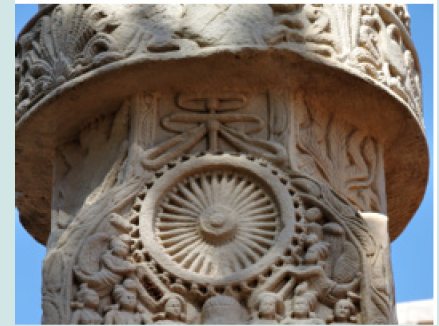
After the Left-Knee King, there is the Already Detached King. After the Already Detached King, there is the Body King. After the Body King, there is the Body-Smell King. Then, the Fruit-reward Ve-hicle King, then Ocean King, then Big Ocean King, then Shejuli King, then Big Shejuli King, then Grass King, then Different Grass King, then Kindness King, Big Kindness King, Love King, Big Love King, Dou King, Big Dou King, Nilijia King, Nazhisha King, Wolf King, Ocean Split King, Diamond Arm King, Bed King, Lion Moon King, Nayedi King, Other King, Good Fortune Water King, Very Hot King, Make Light King, Rural Wild King, Small Mount King, Mount King, Flame King, and Bright Flame King.
The Bright Flame King has 101 generation of kings including himself and his offering, who stayed in the Puduoluo City and governed the world. Their last king is called Subdue Complain King, because he can suppress enemies and complains. The Subdue Complain King went to Ayuzhe City, where this king and his following kings governed people for a long time with 54000 kings. Among these kings, the last is Hard-to-be-defeated King. The Hardto- be-defeated King and his offspring governed the city of Va-ranasi (which locates on today’s India near today’s Ganges River), for 63,000 kings. Their last king is named as Hard-to-be-thought King. The Hard-to-be-thought King and his offspring governed the city of Kapilavastu, which locates on today’s Nepal, for 84,000 kings. Their last king is named as Brahmi Merit. The Brahmi Merit King and his offspring governed the city of White Elephant for 32,000 kings. Their last king is named as Elephant Merit. The Elephant Merit King and his offspring governed the city of Rampurva, which locates on today’s India, for 32,000 kings. Their last king is named as Herbal Scent. The Herbal Scent King and his offspring governed the city of Yuluozhe for 32,000 kings. Their last king is named as Najianazhe. The Najianazhe King and his offspring governed the city of Hard Subdue for 32,000 kings. Their last king is named as Surrender Other. The Surrender Other King and his offspring governed the city of Genajiuzhe for 12,000 kings. Their last king is named as Victory Army. The Victory Army King and his offspring governed the city of Bobo for 18,000 kings. Their last king is named as Heaven Dragon. The Heaven Dragon King and his offspring governed the city of Duomolizhe for 25,000 kings. Their last king is named as Ocean Sky. The Ocean Sky King and his offspring govern the city of Duomolizhe for 10,000 kings. Their last king is also named as Ocean Sky. The Ocean Sky (II) King and his offspring governed the city of Chanduofuluo for 18,000 kings. Their last king is named as Good Mind. The Good Mind King and his offspring governed the big city of Rajgir, which locates on today’s India, for 25,000 kings. Their last king is named as Good Govern. The Good Govern King and his offspring governed the city of Varanasi for 1,100 kings. Their last king is named as Big Emperor King. The Big Emperor King and his offspring governed the big city of Maozhu for 84,000 kings. Their last king is again named as Ocean Sky. That Ocean Sky King (III) and his offspring governed the city of Puduoluo for 1500 kings. Their last king is named as Kassa (meaning the practice of hardship). The Kassa King and his offspring governed the big city of Maozhu again, for 84,000 kings. Their last king is called Earth Surface.
The Earth Surface King and his offspring are totally 1000 kings. Then, there are Hold Land King, which has offspring of 80,000 kings. Then, there are Landlord King, which has offspring of 84,000 kings. Then, there are Big Sky King, which has offspring of 84,000 kings. Then, Wheel Rotating (Nimi) King, Sink King, Strong Navel King, Henu King, Youbo King, Numo King, Good-see King, Moon-see King, Heard Army King, Darma Army King, Subdue King, Big Subdue King, Again Surrender King, No-worry King, Remove-worry King, Shoulder King, Joint King, Moluo King, Luona King, Place Lord King, Dust King, Jialuo King, Happy King, Mirror-surface King, Living King, Luoling King, Meal King, Plenty Food King, Hard Surrend King, Kard Defeat King, Peace King, Good Live King, Big Strength King, Strength Merit King, and Hardpractice King. The Hardpractice King has offering of 75000 king. Then there are Good Establish King, which has offspring of 1100 kings. Their last king is called Jiliqi. During the Jialiqi King period, the Kassapa Buddha is enlightened. According to many Buddism sutra, the people at the time of Kassapa Buddha can live for 20000 years. The people at the time of Kassapa Buddha have declined morality, so the Kassapa Buddha came to salvage them. The Kassapa Budha’s body was twenty cubits high (one cubit is longer than a feet). At that time, the human’s body shape, height, life span, and morality are not as good as previous human beings in the early earth, but still much better than now. According to Tibetan literature, at Kassapa Buddha’s time, the king, who is the father of Kassapa Buddha, governs the most areas of the earth including the China and India [7].
The Jialiqi has a son called Good Born, who has offspring of 110 kings. The last of which is called Ear King. The Ear King has two sons. The firs son is Juyue, who becomes the king. He has a son called Cane Seed. The Cane Seed has 110 offspring kinds. The last one is called Not Good. The Not Good King has four sons. The fourth son is named as Zujubo. The Zujubo king has a son called as Sky City, who has son called Cow City. The Cow City King and his offspring governed the city of Duomolizhe for 25,000 kings. Their last king is named as Ocean Sky. The Ocean Sky King and his offspring governed the city of Kapilavastu for 77,000 kings. Their last king is named as Wide Car King. Then, Other Car King, Solid Car King, Stay Car King, Ten Car King, Hundred Car King, Ninety Car King, Colorful Car King, Wisdom Car King, Wide Arch King, Many Arch King, With Arch King, Stay Arch King, Ten Arch King, Hundred Arch King, ninety Arch King, Colorful Arch King, Wisdom Arch King. The Wisdom Arch King has two sons. His 2nd Son is called Lion Foot who succeed the King position. After he become the king, we born 4 son. The first son is pure-food king, who is the dad of Shakyamuni Buddha, who has one child named Luohuluo. Above is the lineage of king from the first in human kind to the time of Shikamuni. At Shikamuni Buddha’ time, people live up to 120 years. There are more people, who live less than 100 years, than people, who can live over 100 years.
Age of Earth. In the far ancient time, human beings have much longer life spans than the current age. According to Buddhism, from the beginning to the end of this earth, totally there are 1005 Buddhas showing up. The well-known Buddha is the Siddhartha Gautama (Shakyamuni Buddha, the 4th Buddha), born in about 3000 years ago. The next best-known Buddha is Maitreya Buddha, the 5th Buddha, which is the nearest future Buddha who will be born around 0.3-0.4 billion years later. Before this Buddha, there is the 3rd Buddha, the above-mentioned Kassapa Buddha. At the days of Kassapa Buddha, people have the life span of 20,000 years. Before Kassapa Buddha, there is the Kanakamuni Buddha, the 2nd Buddha. At the days of Kanakamuni Buddha, people have the life span of 30,000 years. Before Ka-nakamuni Buddha, there is the Kakusandha Buddha, the 1st Buddha since the formation of our earth. At the days of Kakusandha Buddha, people have the life span of 40,000 years. Before Kakusandha Buddha, there are already human societies and kingdoms.
In the above mentioned the golden age of the first six kings, their lives are too long to be counted by a general human without a super computer. For example, the 6th king, the Top Born King, lived for an Asougi (Sanskrit meaning “uncountable large number”). In Googology, an Asougi is equal to 10^104. In Buddhism, an Asougi is meaning the 10,000x of the number of the sands in Ganger River. Assuming each of the first 6 kings has the similar age as the 6th king, which is 1 Asougi, their golden age last for 6x10^104, far more than the “age of universe” determined by scientists. This puzzle will be discussed in later text.
Later on, after the linages as mentioned above, it enters the time of Kassapa Buddha, when the human can live for 20,000 years. Before that, human can even live much longer. If you calculates the abovementioned numbers of King lineages, considering their expected ages, you can develop a math model. Based on that model, you can find the history of human society is much longer than expected. Accordingly, the earth’s age is longer than that. Thus, the earth age is much older than any numbers proposed so-far by modern science.
Discussion
Religious books/scriptures provide a novel view on human civilization. As aforementioned, from Buddhism point of view, prehistorical human had better life span, which is in line with the Sun Model of Civilization and Sun Theory of Evolution, in which we proposed human had Golden Age before today’s civilization.
As previously mentioned, there are three major approaches to study the ancient history of human civilization: 1. Historyrelated Record; 2. On-site Discovery; 3. Supernatural Exploration. In this article, we focused on the 3rd approach. The supernatural exploration is usually only accessible to top elites, and often carried out secretly because most public civilians are not able to believe that. The aforementioned government-source report (Ancient Mars Exploration by Supernatural Ability), which is open to public [3], could be just a corner of a giant iceberg; most parts of such research have not been dis-closed/uncovered. However, no matter how well the exploration designed, the human objects who have supernatural abilities are in extremely lower level comparing with those ancient sages. For example, the first few books in Bible were written by Moses. Moses was able to split the red sea, turned to a stick to snake [4]…… Such supernatural abilities are out of limits of any modern human beings. As a general civilian, the most effective way to apply the third approach is to study the religious books written or authored by ancient saints with supernatural powers, like Shakyamuni Buddha. It is worthy of men-tioning that the abovementioned Buddhism books are not equal to general history books, because the prehistorical events are observed by Buddha’s wisdom (superpower). Thus, it is an innovative and re-sourceful approach to study the human civilization and earlier earth events from the religious records.
According to the aforementioned Buddhism books, the human beings on the earth are far more than 13 billions, which is deemed the “age of universe”, as assumed by the majority side of literature which is based on the Big-Bang theory. The farthest star discovered is 13 billion light years from earth. Assuming the age of the universe is the time elapsed since the Big Bang, just the majority of scientists believe that 13 billion years is the age of our universe. Not mentioning whether the Bing Bang is right or wrong, the farthest star should be far more than 13 billion light years from us. We just did not find yet due to technical limitations. According to Dr. Sun’s universe model [1], there are invisible matters, named as Sun Matters, in the universe; the Sun Matters will interact with the light and light will be diminished during extremely long-distance traveling. Basically, the universe is older than we can imagined. The lights from more faraway stars could be completely filtered out by Sun Matters, and human beings can enjoy the dark sky at night (if not considering the modern light pollution). A group of Ottawa scientist thought the age of universe should be longer, like 26 billion years, which is still much shorter than the life span of an ancient king, the above-mentioned Top King, whose stories was told according to Buddha’s observation. Anyway, the current method of calculating universe age is not reliable. Furthermore, the Buddhism viewpoint about the age of universe can be easily testified in future. Currently, there is a lack of hard physical evidence like very-veryold rocks, due to the continuous geological moment of earth surface and technical limitations, all rocks that found in modern time are relatively young. In future space exploration, the speculations about the longer earth age and universe age can be testified if human beings can find many rocks that are older than the “age of universe” that calculated based on current science regime.
Acknowledgements
W.S. and G.S. would thank the great people who are able to preserve the religious records/books for thousands of years. Generation by generation, with tremendous efforts.
References
- Sun W (2024) Solving the Olbers’s Paradox, Explaining the “Red-Shift”, and Challenging the Relativities by "Sun Matters Theory" and "Sun Model of Universe", an Evolution of Einstein's Static Universe Model. Natural Science 16(2): 7-18.
- Sun W (2024) Solving the Darwinian Paradoxes by “Sun Model of Civilization”, Re-Examine the Origin of Human. J Anthro & Archeo Sci 9(2): 1200-1211.
- CIA (1984, May 22) Mars Exploration. Retrieved from MARS EXPLORATION, MAY 22, 1984 - The World Factbook.
- Bible (1973) The Holy Bible (NIV Version). Colorado Springs, CO, USA: International Bible Society.
- NASA News Release. (2006). Space and Astronomy News. Retrieved from UNIVERSE TODAY: https://www.universetoday.com/11246/shadows-on-the-moon/Brandenburg, J. E. (2016). Evidence for Past, Massive, Nuclear Explosions on Mars, and its Relationship to Fermi’s Paradox and The Cydonian Hypothesis. AIAA SPACE Forum (pp. 10.2514/6.2016-5529). Long Beach, California: AIAA SPACE 2016.
- Trāyastriṃśa (2016) Retrieved from Tibetan Buddhist Encyclopedia (2023). The Role of Abolishing Gravity in Ancient Egyptian Pyramids Architecture. Archaeological Discovery 11(1): 16-37.
- Gampo S (650 CE) (1996) History in Column (Biography of Songtsen Gampo King and Remaining Teachings). Tibet: Retrieved by The Honorable Atisha Monk. Golovin S.

Top Editors
-

Mark E Smith
Bio chemistry
University of Texas Medical Branch, USA -

Lawrence A Presley
Department of Criminal Justice
Liberty University, USA -

Thomas W Miller
Department of Psychiatry
University of Kentucky, USA -

Gjumrakch Aliev
Department of Medicine
Gally International Biomedical Research & Consulting LLC, USA -

Christopher Bryant
Department of Urbanisation and Agricultural
Montreal university, USA -

Robert William Frare
Oral & Maxillofacial Pathology
New York University, USA -

Rudolph Modesto Navari
Gastroenterology and Hepatology
University of Alabama, UK -

Andrew Hague
Department of Medicine
Universities of Bradford, UK -

George Gregory Buttigieg
Maltese College of Obstetrics and Gynaecology, Europe -

Chen-Hsiung Yeh
Oncology
Circulogene Theranostics, England -
.png)
Emilio Bucio-Carrillo
Radiation Chemistry
National University of Mexico, USA -
.jpg)
Casey J Grenier
Analytical Chemistry
Wentworth Institute of Technology, USA -
Hany Atalah
Minimally Invasive Surgery
Mercer University school of Medicine, USA -

Abu-Hussein Muhamad
Pediatric Dentistry
University of Athens , Greece

The annual scholar awards from Lupine Publishers honor a selected number Read More...




